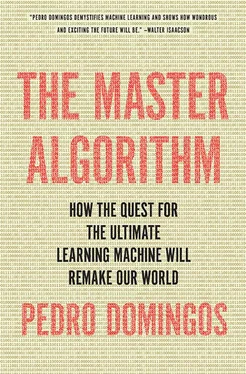Analogizers learn by hypothesizing that entities with similar known properties have similar unknown ones: patients with similar symptoms have similar diagnoses, readers who bought the same books in the past will do so again in the future, and so on. MLNs can represent similarity between entities with formulas like People with the same tastes buy the same books . Then the more of the same books Alice and Bob have bought, the more likely they are to have the same tastes, and (applying the same formula in the opposite direction) the more likely Alice is to buy a book if Bob also did. Their similarity is represented by their probability of having the same tastes. To make this really useful, we can have different weights for different instances of the same rule: if Alice and Bob both bought a certain rare book, this is probably more informative than if they both bought a best seller and should therefore have a higher weight. In this case the properties whose similarity we’re computing are discrete (bought/not bought), but we can also represent similarity between continuous properties, like the distance between two cities, by letting an MLN have these similarities as features. If the evaluation function is a margin-style score function instead of the posterior probability, the result is a generalization of SVMs, the analogizers’ master algorithm. A greater challenge for our master learner is reproducing structure mapping, the more powerful type of analogy that can make inferences from one domain (e.g., the solar system) to another (the atom). We can do this by learning formulas that don’t refer to any of the specific relations in the source domain. For example, Friends of smokers also smoke is about friendship and smoking, but Related entities have similar properties applies to any relation and property. We can learn it by generalizing from Friends of friends also smoke , Coworkers of experts are also experts , and other such patterns in a social network and then apply it to, say, the web, with instances like Interesting pages link to interesting pages , or to molecular biology, with instances like Proteins that interact with gene-regulating proteins also regulate genes . Researchers in my group and others have done all of these things, and more.
Alchemy also enables the five types of unsupervised learning we saw in the previous chapter. It does relational learning, obviously, and in fact that’s where most of its applications to date have been. Alchemy uses logic to represent relations among entities and Markov networks to let them be uncertain. We can turn Alchemy into a reinforcement learner by wrapping delayed rewards around it and using it to learn the value of each state in the same way that traditional reinforcement learners use, say, a neural network. We can do chunking in Alchemy by adding a new operation that condenses chains of rules into single rules. (For example, If A then B and If B then C into If A then C .) An MLN with a single unobserved variable connected to all the observable ones does clustering. (An unobserved variable is a variable whose values we never see in the data; it’s “hidden,” so to speak, and can only be inferred.) MLNs with more than one unobserved variable do a kind of discrete dimensionality reduction by inferring the values of those (fewer) variables from the (more numerous) observable ones. Alchemy can also handle MLNs with continuous unobserved variables, which would be needed to do things like principal-component analysis and Isomap. So Alchemy can in principle do all the things we want Robby the robot to do, or at least all the things we’ve discussed in this book. Indeed, we’ve used Alchemy to let a robot learn a map of its environment, figuring out from its sensors where the walls and doors are, their angles and distances, and so on, which is the first step in building a competent housebot.
Finally, we can turn Alchemy into a metalearner like stacking by encoding the individual classifiers as MLNs and adding or learning formulas to combine them. This is what DARPA did in its PAL project. PAL, the Personalized Assistant that Learns, was the largest AI project in DARPA history and the progenitor of Siri. PAL’s goal was to build an automated secretary. It used Markov logic as its overarching representation, combining the outputs from different modules into the final decisions on what to do. This also allowed PAL’s modules to learn from each other by evolving toward a consensus.
One of Alchemy’s largest applications to date was to learn a semantic network (or knowledge graph, as Google calls it) from the web. A semantic network is a set of concepts (like planets and stars) and relations among those concepts (planets orbit stars). Alchemy learned over a million such patterns from facts extracted from the web (e.g., Earth orbits the sun). It discovered concepts like planet all by itself. The version we used was more advanced than the basic one I’ve described here, but the essential ideas are the same. Various research groups have used Alchemy or their own MLN implementations to solve problems in natural language processing, computer vision, activity recognition, social network analysis, molecular biology, and many other areas.
Despite its successes, Alchemy has some significant shortcomings. It does not yet scale to truly big data, and someone without a PhD in machine learning will find it hard to use. Because of these problems, it’s not yet ready for prime time. But let’s see what we can do about them.
Planetary-scale machine learning
In computer science, a problem isn’t really solved until it’s solved efficiently. Knowing how to do something isn’t much use if you can’t do it within the available time and memory, and these can run out very quickly when you’re dealing with an MLN. We routinely learn MLNs with millions of variables and billions of features, but this is not as large as it seems because the number of variables grows very quickly with the number of entities in the MLN: if you have a social network with a thousand people, you already have a million possible pairs of friends and a billion instances of the formula Friends of friends are friends .
Inference in Alchemy is a combination of logical and probabilistic inference. The former is done by proving theorems and the latter by belief propagation, MCMC, and the other methods we saw in Chapter 6. We’ve combined the two into probabilistic theorem proving, and the unified inference algorithm, capable of computing the probability of any logical formula, is a key part of the current Alchemy system. But it can be very computationally expensive. If your brain used probabilistic theorem proving, the proverbial tiger would eat you before you figured out to run away. That’s a high price to pay for the generality of Markov logic. Your brain, having evolved in the real world, must encode additional assumptions that allow it to do inference very efficiently. In the last few years, we’ve started to figure out what they might be and encode them into Alchemy.
The world is not a random jumble of interactions; it has a hierarchical structure: galaxies, planets, continents, countries, cities, neighborhoods, your house, you, your head, your nose, a cell on its tip, the organelles in it, molecules, atoms, subatomic particles. The way to model it, then, is with an MLN that also has a hierarchical structure. This is an example of the assumption that the learner and its environment are alike. The MLN doesn’t have to know a priori which parts the world is composed of; all Alchemy has to do is assume that the world has parts and look for them, rather like a newly made bookshelf assumes that there are books but doesn’t yet know which ones will be placed on it. Hierarchical structure helps make inference tractable because subparts of the world interact mostly with other subparts of the same part: neighbors talk more to each other than to people in another country, molecules produced in one cell react mostly with other molecules in that cell, and so on.
Читать дальше












